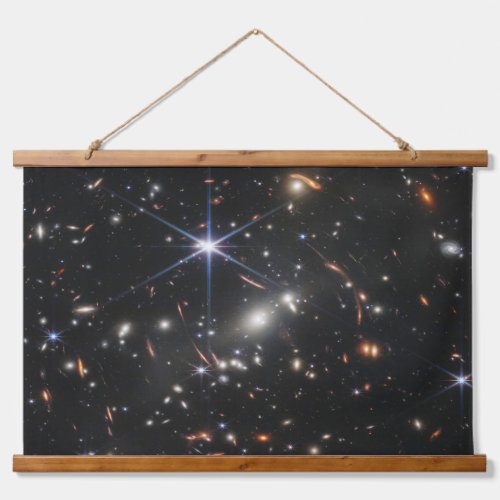Galaxy Cluster Smacs 0723. Hanging Tapestry



Thousands of galaxies flood this near-infrared image of galaxy cluster SMACS 0723. High-resolution imaging from the James Webb Space Telescope combined with a natural effect known as gravitational lensing made this finely detailed image possible. First, focus on the galaxies responsible for the lensing: the bright white elliptical galaxy at the center of the image and smaller white galaxies throughout the image. Bound together by gravity in a galaxy cluster, they are bending the light from galaxies that appear in the vast distances behind them. The combined mass of the galaxies and dark matter act as a cosmic telescope, creating magnified, contorted, and sometimes mirrored images of individual galaxies. Clear examples of mirroring are found in the prominent orange arcs to the left and right of the brightest cluster galaxy. These are lensed galaxies - each individual galaxy is shown twice in one arc. Webb's image has fully revealed their bright cores, which are filled with stars, along with orange star clusters along their edges. Not all galaxies in this field are mirrored - some are stretched. Others appear scattered by interactions with other galaxies, leaving trails of stars behind them. One galaxy speckled with star clusters appears near the bottom end of the bright central star's vertical diffraction spike - just to the right of a long orange arc. The long, thin ladybug-like galaxy is flecked with pockets of star formation. Because this galaxy is so magnified and its individual star clusters are so crisp, researchers will be able to study it in exquisite detail, which wasn't previously possible for galaxies this distant. The galaxies in this scene that are farthest away - the tiniest galaxies that are located well behind the cluster - look nothing like the spiral and elliptical galaxies observed in the local universe. They are much clumpier and more irregular. Webb's highly detailed image may help researchers measure the ages and masses of star clusters within these distant galaxies. This might lead to more accurate models of galaxies that existed at cosmic spring, when galaxies were sprouting tiny buds of new growth, actively interacting and merging, and had yet to develop into larger spirals.


